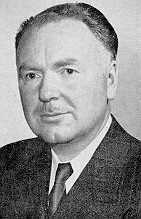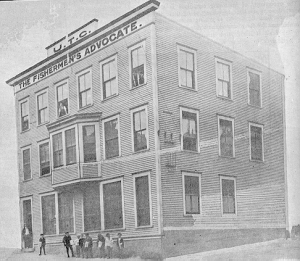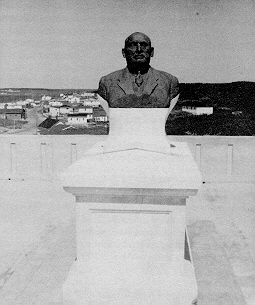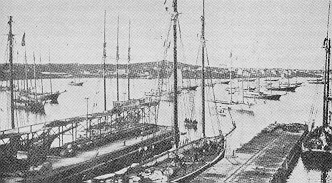

The casual visitor to Port Union is usually surprised to see the extent of the Trading Company's plant and the town-like impression that this community gives.
The average citizen takes it all for granted, but the visitor is astonished to know that here in the north there is a huge, up-to-date fish export business, self-contained and with one of the most modern department stores outside St. John's, and that the town has its own electric light and power plant, shipping facilities and press.
To begin with a quiet tour of the town it would be worth while to go upstairs and begin with the manager's office on the top flat. From the windows there you have an unexpected view of the harbour, wharves below, and of Trinity Bay stretching sway in the distance, usually dotted with the sails of vessels carrying our country's merchandise.
Here in modern, splendidly lighted and well furnished offices the Manager and President of the Company, Mr. H.A. Dawe, with Mr. Charles R. Norris, assistant manager and Mr. Fred Thistle and Mr. Leslie Baker, accountants, direct the Company's business.
Downstairs, on the second floor, Mr. Artno Winsor, wholesale manager, lives these days in an atmosphere of Christmas decorations, gifts and toys - in fact a veritable children's heaven. In the general store below a busy staff waits on numerous customers and have a very busy time.
Outside on the wharf Mr. Charles Bryant directs the outdoor activities while the retail store, fronting on the wharf, is ably managed by Mr. Frank Bailey and Mr. Cecil Rideout.
On a fine day in late summer or fall when the fish business is at its height, between 100 and 130 men are employed on the wharves. Around twenty schooners fit out for the Labrador fishery from the plant, and the names Blackwood, Rogers, Parsons and others are as well known here as in their home towns.
The cooper loft, under the management of Mr. Wilfred Granter, is a hive of industry. Employing from 25 to 30 men, at times, it has an output of from 35,000 to 40,000 casks, drums, etc.
The Trading Company handles from fifty to seventy thousand quintals of fish annually. To collect this fish and to handle the trade of the Company, there are three motor vessels - The "Swile" commanded by Captain Fred Tulk, the "Young Hood," Captain James Goodyear, and the "F.P. Union," Captain Eric Norman.
Before we leave the wharf, let us stop for a minute at the machine shop, where Mr. Sandy Pelley is monarch of all he surveys. Mr. Pelley has installed and repaired more engines than any other man on the coast.
Across from the machine shop is the forge, where Mr. Nathaniel Sheppard, like the village blacksmith of Longfellow's poem, makes the fire and sparks that attract not only children but grown ups as well.
The Goodyear Hotel, on the other side of the road, managed by Mrs. Abraham Goodyear, extends hospitality to visitors and friends who stop over at the town.
Driving the trucks are Mr. Billy Pardy and Mr. Lou Bailey.
The whole plant night time is under the care of Mr. Jack King, night watchman.
Around the cove is the Postal and Wireless Office, and there the genial Dan King looks after whatever urgent business the public may require. In the same building is the Customs Office and there Mr. Walter White, who is much in demand, pursues his duties.
The Union Electric Light and Power Company, apart from supplying power and light to Port Union and its industries, lights Catalina, Little Catalina, Elliston and Bonavista - at the latter town there a hospital and cold storage plants. The Electric Company is under the management of Mr. Aaron Bailey.
Port Union also has its Press, and it is here, from the fishermen's Advocate Office, Mr. M.W. Cook, the press foreman, has been here for sixteen years, and it is difficult to visualize the Advocate office without this veteran newspaper man.
The Linotype operator, Mr. J.B. Cook, while still a young man, has been looking after his end of the paper for fourteen years.
For years, until his death last September, Mr. J.H. Scammell, was the editor of the Advocate, and the names Advocate and Scammell were almost synonymous. Since his death, Mr. Charles Granger has been the editor of this paper. For years the Advocate has been outstanding as the champion of the fishermen of this country and it will continue to be so.

It has been some time since the dock and seal factory have been used, but changing conditions in demands and markets will, we hope, revive these industries.
Crowning Port Union is the Church of Holy Martyrs, a splendid edifice dominating the skyline of the town. Above and beyond the town is the Congress Hall and near it is the tomb of Sir William Coaker, the founder and builder of the F.P.U., Port Union and its industries.

Now with the approach of winter, as the rush of the fall's business gives way to the season of leisure, Christmas decorations enliven the strict routine of business and there is a breathing spell for the citizens of the town, which gives rest for the busy days which will come with another spring.
